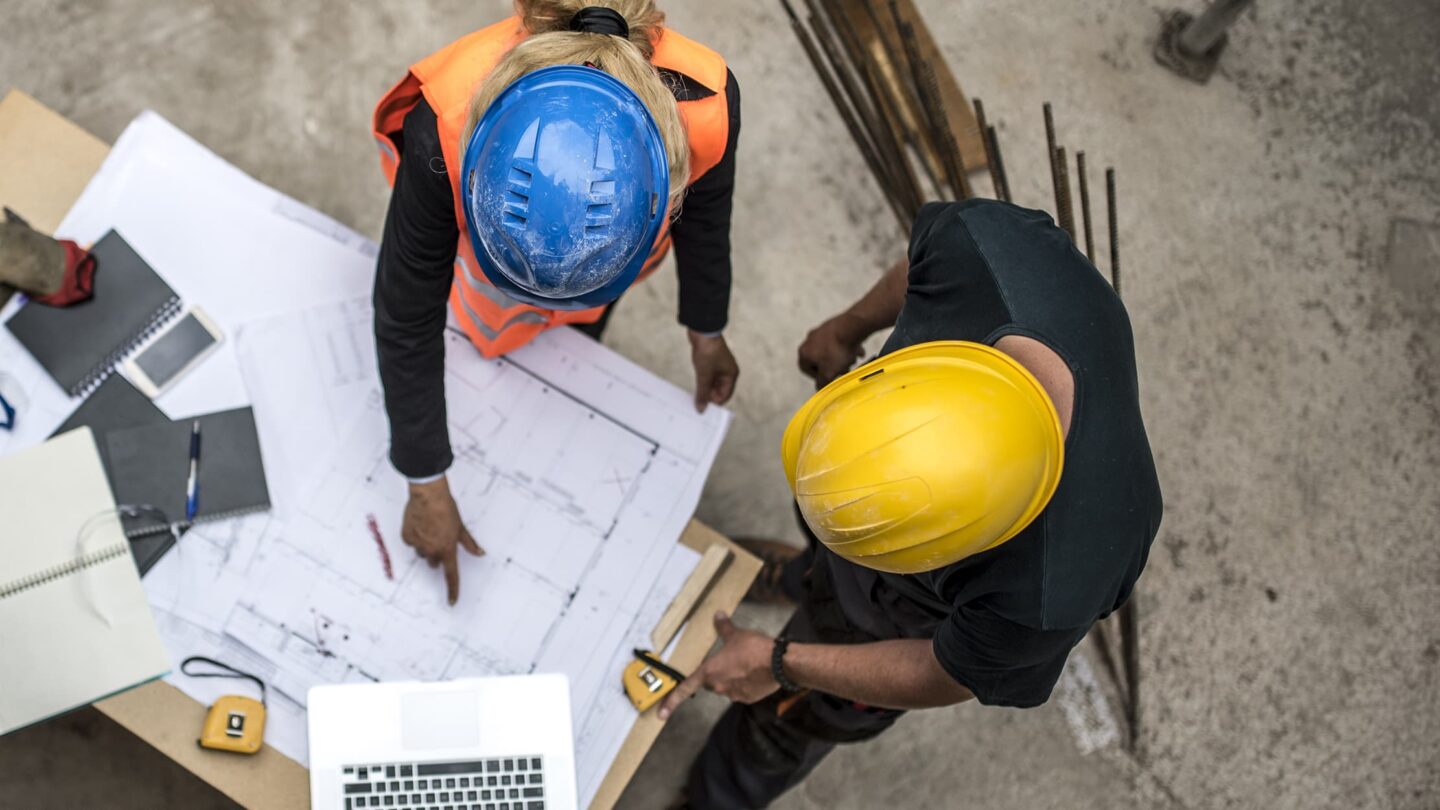Money Matters
Construction Industry Scheme: How the VAT reverse charge affects your business
VAT changes could hit firms covered by the Construction Industry Scheme. Learn about the VAT reverse charge, which started on 1 March 2021.

A shake-up of VAT rules could impact the cash flow of 150,000 small and medium businesses in the UK construction sector, many of whom are covered by the Construction Industry Scheme (CIS).
Read this article to make sure you don’t get caught out – it covers details about the new domestic reverse charge, offers tips to help you with it, and there’s also a refresher on the CIS and how it works.
Here are the topics covered in the article:
Introduction of the VAT domestic reverse charge for construction
How does the domestic reverse charge work?
What is the 5% disregard for VAT reverse charge?
What the reverse charge means for subcontractors
What the reverse charge means for contractors
Why has the VAT reverse charge happened?
A refresher on the Construction Industry Scheme
Conclusion on the VAT domestic reverse charge
Introduction of the VAT domestic reverse charge for construction
For almost 50 years, UK suppliers have accounted for their own VAT. Many small and medium-sized enterprises (SMEs) use VAT payments from customers as a source of working capital before sending the funds to HMRC.
However, that’s changed. VAT cash no longer flows between VAT registered businesses involved in the construction industry.
On 1 March 2021, the UK government rolled out a reverse charge initiative aimed at tackling fraud totalling millions of pounds per year.
The fraud is caused when suppliers or ‘subcontractors’ charge main contractors VAT but ‘disappear’ before passing sums on to HMRC.
The VAT reverse charge rules apply to suppliers of specified services, reported under the CIS.
The changes also apply to goods, where those supplies are provided alongside services specified in the CIS. This will see many more businesses affected than first thought.
It’s anticipated that the businesses most directly affected by the building and construction legislation will be those which supply services to main contractors, or that operate through recruitment agencies or umbrella companies.
How does the domestic reverse charge work?
Suppliers are no longer required to charge or receive VAT from their main contractor customers.
Instead, main contractors effectively charge themselves VAT on subcontractors’ services, and pay the VAT sums that would have been paid to the subcontractor direct to HMRC in their VAT returns.
Now, for impacted suppliers, subcontractors need to issue domestic reverse charge VAT invoices to main contractors, which must include wording that reverse VAT rules apply and that the customer must account for the VAT.
This requirement applies through the supply chain until main contractors sell to end users (clients) who do not sell on services.
The new arrangements only apply to:
- Individuals or businesses registered for VAT in the UK, which sell to other VAT-registered businesses
- Entities that provide services specified under CIS. These include the construction, renovation and demolition of structures; painting and decorating, as well as services such as heating, ventilation and air conditioning.
The arrangements don’t apply to businesses providing other support services such as surveying, architecture and consultancy; machinery, drilling or extraction, and the installation of security systems.
HMRC covers a full breakdown of services are that are included and exempt under CIS.
When there is one reverse charge element in a supply, the entire supply would be subject to the domestic reverse VAT charge.
It means that:
- New rules would not apply to the supply of wood for a staircase
- But new rules would apply for the supply of wood for a staircase, if the invoice for the supply of wood is combined with its construction and installation.
This represents a change because CIS payments were apportioned and no deductions were made on the materials content.
Once the domestic reverse VAT charge has been applied, subsequent supplies are also covered, provided the buyer and supplier agree.
The aim is to speed up the decision-making process on whether the domestic reverse VAT charge should apply.
Read more about construction and VAT
- VAT domestic reverse charge for construction: 23 things you need to know
- A guide to registering for VAT
- What is VAT? UK VAT basics
- How to understand and manage VAT for your business
What is the 5% disregard for VAT reverse charge?
The VAT reverse charge says certain work undertaken by a subcontractor must have the reverse charge applied if that work falls under the CIS.
A general list of the work that does fall under the CIS, and the work that doesn’t, can be found on the government’s website.
This is true if a subcontractor invoices for a mixture of work – so called mixed invoices – of which some falls under the CIS VAT reverse charge rules, but the rest doesn’t. In this case, the VAT reverse charge should be used.
But there’s an important exception.
If the component of the invoice for work that falls under the CIS VAT reverse charge rules is just 5% or less of the total amount invoiced, then the normal VAT rules are applied, and the CIS VAT reverse charge isn’t used.
For example, installing a security system does not fall under the CIS reverse charge rules. Installing lighting does.
So, if an electrician were to visit a site to wire a security system and also took care of some lighting wiring while there, and the latter work represented 5% of less of the invoice amount, then the CIS VAT reverse charge should not be applied to the entire invoice.
But if the lighting wiring work was 10%, for example, then the VAT reverse charge should be applied to the entire invoice.
What the reverse charge means for subcontractors
As a first step, you need to verify that the contractor is VAT registered.
Once you’ve confirmed they are VAT registered then instead of ‘charging’ customers VAT, you need to issue VAT reverse charge invoices – stating the services provided are subject to domestic reverse VAT rules.
You’ll no longer receive VAT from customers to send to HMRC.
After you’ve issued a reverse charge VAT invoice, the responsibility for charging, and accounting for, VAT sits with your customer (the contractor) who receives your services.
What the reverse charge means for contractors
Instead of paying suppliers for their services inclusive of VAT, you need to pay them exclusive of VAT and account for (i.e. record in your bookkeeping system and VAT return) the appropriate VAT that would have been due, categorised by the normal tax rates (standard rate, reduced rate, or zero rate).
The details needed to record the VAT will be on the invoice that the VAT registered subcontractor sends you, along with wording to remind you that you need to account for the VAT via the reverse charge mechanism.
You then charge yourself for subcontractors’ VAT at the appropriate rate and recover in your VAT return using reverse charge VAT rules.
Why has the VAT reverse charge happened?
The simplest way to remove subcontractor VAT fraud (also known as carousel fraud) is to remove the ability to charge and collect VAT from the participants.
That way, there’s no flow of money and hence it’s harder to defraud.
Because the reverse charge makes it the responsibility of the contractors to account for VAT, there’s no opportunity for subcontractors (who are the suppliers) to ‘disappear’ without paying the tax to HMRC.
What do I do now?
Whether buying or supplying, all businesses that operate within the construction sector should act now to get up to speed with the new rules.
Construction firms should also prepare to deal with an increase in administration connected with the new arrangements.
Seven key steps to take now
1. Review your existing business relationships
Be proactive.
Buyers and suppliers within the construction supply chain should review transactions between their own VAT-registered businesses and other VAT-registered organisations.
The aim is to work out whether reverse VAT charges affect your sales, purchases or both.
Whatever your status, it would be helpful to tell your clients and suppliers about the changes in order to keep the supply chain moving.
Contractors: Tell subcontractors whether or not you are at the end of supply chains. This could be commercially sensitive but is essential in working out whether the reverse VAT charge applies.
If you do not provide this information to suppliers, you will be responsible for accounting for the domestic reverse VAT charge.
Subcontractors: Determine whether the services you provide are included within the list of specified services in CIS.
If you supply materials, consider whether you provide these as a standalone supply (not subject to reverse VAT charges) or alongside supporting services such as installation – ‘packages’ that would be subject to new VAT rules.
You should stop charging VAT on services for main contractors and start issuing reverse charge VAT invoices instead of normal VAT invoices.
2. Review systems and processes
Subcontractors: Adapt your invoicing systems and processes (if you haven’t already) in order to correctly send invoices inclusive of VAT or to send reverse charge VAT invoices.
Contractors: You need systems in place so you can correctly account for VAT on reverse charge VAT invoices received from subcontractors and report on these sums to HMRC.
3. Prepare for a potential change to your cash flow
Subcontractors: Consider the impact on your cash flow of not receiving VAT from your customers. Think about ways to mitigate the impact.
Contractors: The changes are not expected to affect your cash flow because they are tax neutral. However, it’s worth being mindful of the impact that VAT changes may have on your suppliers.
4. Ask for help
HMRC recognises that this marks a fairly big change for businesses in the construction sector. It has published guidance on the scheme.
If you need support with the domestic reverse charge, contact HMRC, speak to your accountant (if you have one) or contact a VAT specialist.
5. Don’t panic
HMRC has said it will operate a ‘light touch’ on genuine mistakes and penalties for a six-month period from 1 March 2021, when the reverse charge came into effect.
This is on the condition that companies are trying to comply with the new legislation and have acted in good faith.
HMRC offices may assess for mistakes during this initial period but will only consider penalties if people are found to be deliberately taking advantage of the measure through poor accounting.
Errors need to be amended as soon as possible because the longer inaccurate sums remain outstanding, the harder it may be to correct or recover them.
6. Keep good records
Contractors: Keep accurate records relating to the calculation and VAT accounting for reverse charges and ensure VAT is correctly processed.
This is in addition to keeping track of how much CIS tax you withhold from subcontractors in your accounting.
You also need to verify the status of subcontractors; that their services are covered by CIS and that your subcontractors are not issuing you VAT inclusive invoices when they should be invoicing under the reverse charge VAT regime.
Subcontractors: Keep track of which of your customers are not end-users but are VAT registered, and for these customers you may need to issue reverse charge VAT invoices.
7. Check your house is in order
Businesses operating within the construction sector must check they are registered appropriately with the HMRC Construction Industry Scheme (CIS).
A refresher on the Construction Industry Scheme
The CIS outlines special tax rules for buyers and suppliers operating in the construction industry.
Under CIS, contractors take deductions from subcontractors’ payments and pass these on to HMRC as advances towards subcontractors’ tax and National Insurance.
New CIS rules are coming into force in April 2021. Read this CIS blog to find out more.
Which services are covered?
According to HMRC, the CIS covers most construction work including permanent or temporary buildings and structures, as well as civil projects such as roads and bridges.
This includes preparing sites, providing access works, demolitions, building, alterations, repairs and decorating, installing systems for heating, lighting and power, and cleaning the inside of buildings after construction work.
Material issue
There are a range of exemptions for CIS – notably for ‘associated services’ or the standalone supply of materials.
For a full list of what is and isn’t covered under the Construction Industry Scheme, visit the CIS guide for contractors and subcontractors.
How does CIS work?
Businesses that are part of the construction supply chain need to register for the CIS – either as a contractor, a subcontractor or both.
Construction Industry Scheme contractors
You must register as a contractor if either:
- You pay subcontractors to carry out construction work
- You spend an average of more than £1m a year on construction in any three-year period – even if your business doesn’t do construction work.
Under the CIS tax return, contractors must check that subcontractors are registered with HMRC, pay them, deduct tax, and submit online monthly statements confirming these payments.
Construction Industry Scheme subcontractors
It is worth registering as a CIS subcontractor if you do work for a contractor. You don’t have to sign up – but if you don’t, deductions from your payments might be made at a higher rate.
After registering with HMRC, you must update them with any changes to your business, such as the company name, address and partners.
I am a contractor and a subcontractor
You should register as a contractor and a subcontractor if you buy and supply construction services.
Conclusion on the VAT domestic reverse charge
Now the domestic reverse charge is in force, if you haven’t got your processes in place for it, take action to do so now.
You should also speak to your contacts and suppliers, and if you need additional help, turn to a VAT specialist or accountant.
Editor’s note: This article was first published in July 2019 and has been updated for relevance.
Tackling the Construction Industry Scheme with Sage Accounting
Learn about the Construction Industry Scheme and your legal responsibilities, and find out about the new VAT reverse charge for construction.








Hi
Am a running a limited company, subcontracting job is our main activity in construction field, main company always didactic 20 % CIS from my payments. My question is what are the changes in CIS reversal scheme and how’s that going to effect me, can we collect CIS from the main contractor? Instead of collecting from the HMRC?
2nd question, am in VAT flat rate scheme all ways collect 20% from main contractors and payed 10.5 % to HMRC, the new system changed everything, can we collect 9.5% from the HMRC? Instead of collecting expenses Vat from HMRC?.
Jacob
The article above included the following comments
“This represents a change because CIS payments were apportioned and no deductions were made on the materials content.”
Is this section of the article saying cis tax now needs to be deducted on materials element when it wasn’t before ? if not what is the major change being referred to specifically in this sentence?
we are cis registered paid gross in the construction industry……………most of my customers are NOT end users therefore I am applying the reverse charge vat scheme commencing 1st March 2021
Are my main suppliers of glass and door furniture subject to the same reverse vat scheme and should they be invoicing me without VAT?
Hi,
This is something HMRC will need to discuss with you. You can contact them directly to discuss this here http://1sa.ge/bDjv50BBhom or on 0300 322 9434.
In addition, you can find the answers to common CIS Reverse Charge questions here http://1sa.ge/VO4450DU9TH and join our CIS Domestic Reverse Charge VAT Webinar to learn more at https://www.sage.com/en-gb/cp/cis-domestic-reverse-charge/
Regards,
Paul
Sage UKI
hello, quick question when we enter a subcontractor to whom we have to deduct 20% tax and before new rules add VAT the figure is not correctly calculated and we enter manually, ho wwil this work with new rules?
Hi Nigel,
You can find the answers to common CIS Reverse Charge questions here http://1sa.ge/VO4450DU9TH.
You can also join our CIS Domestic Reverse Charge VAT Webinar to learn more at https://www.sage.com/en-gb/cp/cis-domestic-reverse-charge/
If you’re still require support then our Q&A Live team will be able to look at this with you. This specialist team are available Monday to Friday, 9am to 5pm at http://www.sage.com/uk/qa and will response in minutes, if not seconds and provide you with real time support.
Regards,
Paul
Sage UKI
Good morning, how are Sage amending their systems so that I can clearly show the legally required changes on my invoices?
Hi Richard,
If you’re using Sage 50cloud Accounts v25 or below you can install the latest version of Sage 50cloud Accounts via our Installation Hub at http://1sa.ge/KV3650DUaKb to bring the CIS Reverse Charge invoice layouts through.
Or, you can edit your invoice layout to show Domestic Reverse Charge in Report Designer. Full steps on how to do this here http://1sa.ge/60Uv50DUaKa
You can find the answers to common CIS Reverse Charge questions here http://1sa.ge/VO4450DU9TH and join our CIS Domestic Reverse Charge VAT Webinar to learn more at https://www.sage.com/en-gb/cp/cis-domestic-reverse-charge/
Regards,
Paul
Sage UKI
is there a full list of exemptions to reverse VAT?
Hi Nigel,
You can view info on the new VAT Domestic Reverse Charge rules for construction services in March 2021 in our article here http://1sa.ge/icfl50DENy9
You can also visit HMRC’s webpage on this at https://www.gov.uk/what-is-the-construction-industry-scheme
Regards,
Paul
Sage UKI